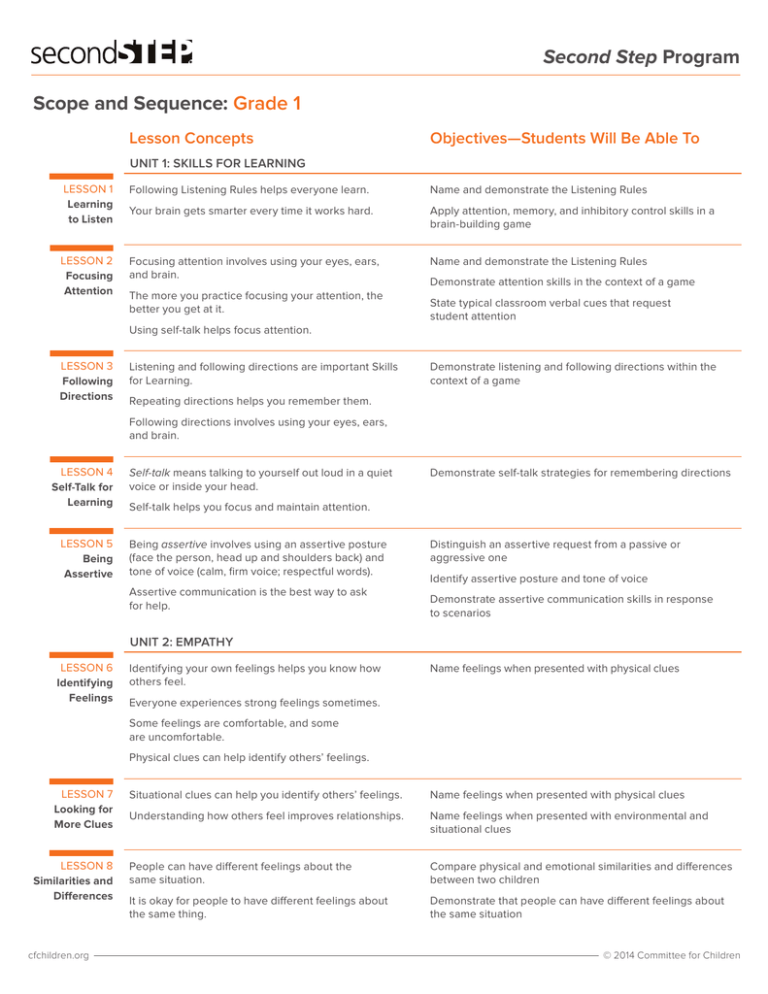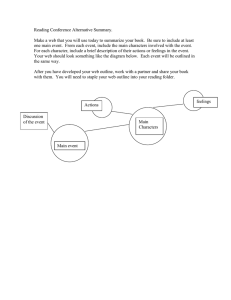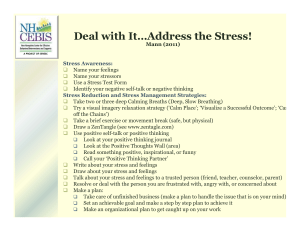Second Step Program Scope and Sequence: Grade 1
advertisement

Second Step Program Scope and Sequence: Grade 1 Lesson Concepts Objectives­—Students Will Be Able To UNIT 1: SKILLS FOR LEARNING LESSON 1 Learning to Listen Following Listening Rules helps everyone learn. Name and demonstrate the Listening Rules Your brain gets smarter every time it works hard. Apply attention, memory, and inhibitory control skills in a brain-building game LESSON 2 Focusing Attention Focusing attention involves using your eyes, ears, and brain. Name and demonstrate the Listening Rules The more you practice focusing your attention, the better you get at it. Demonstrate attention skills in the context of a game State typical classroom verbal cues that request student attention Using self-talk helps focus attention. LESSON 3 Following Directions Listening and following directions are important Skills for Learning. Demonstrate listening and following directions within the context of a game Repeating directions helps you remember them. Following directions involves using your eyes, ears, and brain. LESSON 4 Self-Talk for Learning LESSON 5 Being Assertive Self-talk means talking to yourself out loud in a quiet voice or inside your head. Demonstrate self-talk strategies for remembering directions Self-talk helps you focus and maintain attention. Being assertive involves using an assertive posture (face the person, head up and shoulders back) and tone of voice (calm, firm voice; respectful words). Assertive communication is the best way to ask for help. Distinguish an assertive request from a passive or aggressive one Identify assertive posture and tone of voice Demonstrate assertive communication skills in response to scenarios UNIT 2: EMPATHY LESSON 6 Identifying Feelings Identifying your own feelings helps you know how others feel. Name feelings when presented with physical clues Everyone experiences strong feelings sometimes. Some feelings are comfortable, and some are uncomfortable. Physical clues can help identify others’ feelings. LESSON 7 Looking for More Clues LESSON 8 Similarities and Differences cfchildren.org Situational clues can help you identify others’ feelings. Name feelings when presented with physical clues Understanding how others feel improves relationships. Name feelings when presented with environmental and situational clues People can have different feelings about the same situation. Compare physical and emotional similarities and differences between two children It is okay for people to have different feelings about the same thing. Demonstrate that people can have different feelings about the same situation © 2014 Committee for Children Second Step Program Scope and Sequence: Grade 1 LESSON 9 Feelings Change Lesson Concepts Objectives­—Students Will Be Able To People may have different feelings about the same situation at different times. Demonstrate welcoming and inviting behaviors Feelings may change over time. Being inviting and welcoming can change people’s feelings. LESSON 10 Accidents An accident is when you do something you didn’t mean to do. It is important to accept responsibility for an accident to prevent others from assuming it was intentional. LESSON 11 Showing Care and Concern Compassion is empathy in action. People feel better when others show them care and concern. Know what the word accident means Know what to say when they do something by accident Predict how others might feel as a result of their own or others’ actions Recall that listening, saying kind words, and helping are three ways to show caring Demonstrate caring and helping in response to scenarios UNIT 3: EMOTION MANAGEMENT LESSON 12 Identifying Our Own Feelings You identify your own feelings by physical clues in your body. Identify physical clues in their bodies that help them identify their feelings All feelings are natural. Identify grown-ups to talk to about feelings LESSON 13 Strong Feelings Feelings vary in strength. Recognize situations and physical body cues that signal strong feelings Strong feelings need to be managed. Saying “Stop” and naming your feeling are ways to begin to calm down. LESSON 14 Calming Down Anger Belly breathing calms down strong feelings. Explain physical and situational clues to feeling angry Belly breathing pushes the belly out when you breathe in. Demonstrate the proper belly breathing technique Being mean or hurting others when you are angry is not okay. LESSON 15 Self-Talk for Calming Down LESSON 16 Managing Worry cfchildren.org Demonstrate two Calming-Down Steps to manage strong feelings Positive self-talk is an effective strategy for calming down strong emotions. Use a three-step process to calm down: Say “stop,” name your feeling, and do belly breathing Recognize situations that require the use of calming-down strategies Use positive self-talk to calm down Counting is an effective Way to Calm Down. Recognize situations that require the use of calming-down skills The Ways to Calm Down can help students manage worry. Demonstrate the Ways to Calm Down—belly breathing, counting, and using positive self-talk Talking to a grown-up helps when you are worried. Identify grown-ups to talk to when feeling worried © 2014 Committee for Children Second Step Program Scope and Sequence: Grade 1 Lesson Concepts Objectives­—Students Will Be Able To UNIT 4: PROBLEM SOLVING LESSON 17 Solving Problems, Part 1 You need to calm down before you solve a problem. Use words to describe problems presented in scenarios The first step in solving a problem is to use words to describe the problem. Generate multiple solutions to problems presented in scenarios The second step in solving a problem is to think of lots of solutions. LESSON 18 Solving Problems, Part 2 Part of problem solving is thinking about consequences. Predict consequences using an if-then model The final step of problem solving is to pick the best solution. Select a reasonable solution to a problem Solving problems is a way to get along better with others. LESSON 19 Fair Ways to Play Sharing, trading, and taking turns are fair ways to play. Define and differentiate sharing, trading, and taking turns Sharing means playing together with a toy. Identify and state the problem in a given situation Generate possible solutions to a problem situation Demonstrate the Fair Ways to Play LESSON 20 Inviting to Join In It is important to notice and have empathy for children who are left out of play. Inviting others to play is the right thing to do. Apply the Problem-Solving Steps Demonstrate how to invite someone to play in response to scenarios Playing with others is a way to get to know them better. LESSON 21 Handling Name-Calling It is not okay to call people names that hurt their feelings. Demonstrate assertive responses to name-calling Identify adults to tell if name-calling doesn’t stop If someone calls you a name, you can ignore the person or speak assertively. If the person doesn’t stop calling you names, you should tell a grown-up. LESSON 22 Reviewing Second Step Skills You have all learned a lot of new skills. Recall skills on all the posters You can notice how much you have learned. Demonstrate the Listening Rules Demonstrate the Calming-Down Steps Name one concept or skill they learned in their Second Step lessons cfchildren.org © 2014 Committee for Children





